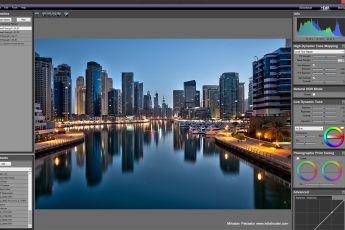I know you all want a post about the blue/black dress (or white/gold?) today, but no, not from me :)
Today’s post is about a question I got few days ago. A question if I knew about any free Photoshop alternative. This is quite an interesting question, and to tell the truth, I knew about none that was really suitable. I’ve been using Photoshop for the last 15 years, and I never thought about looking for something else. So I started searching. For me a Photoshop alternative would have to be a local program that works solidly with layers. I’m not a big fan of online editors that work in a browser, as the stability of browsers is horrible as it is, and I don’t trust them with my work.
Gimp
Over and over again I seen Gimp to be suggested as the best alternative. There are two alternative there, the Gimp and Gimpshop, which is a version that tries to emulate Photoshop more, with more Photoshop like interface. So I decided to give it a try. First I went for the Gimpshop, as that would probably be easier. My experiment ended already by the installer, when it tried to install some strange additional software onto my system and the installation dialog didn’t even had any cancel button. Sorry, that’s not what I want to have on my PC. So I switched to the normal Gimp, at least there I got only what I wanted.
I actually tried Gimp some 10 years ago, and first look at the latest version, it looked exactly as before. So I tried to go and edit a photo. The first big problem was that Gimp does not support 16-bit files (I found an announcement from 2012 that this should be implemented, but not in the current version). Thats already a deal breaker for me, but I thought I try and blend an image. The layers work fine, so the basic blending is possible. While trying to do luminance masking I was not so successful. First I could not find the RGB channel, so I could only work on R, G or B and then the intersection of selection worked strangely, so I could not create more specific selection.
And there where my experiments with Gimp stopped. It is just so far away from my workflow, that I can’t use it. Maybe I just missed something, but the UI just didn’t fit my style.
But if I should suggest you a free Photoshop alternative, this is still the best one you can get. You can use layers, you can do basic blending, you can do image edits. But if you want to edit photos every day, I would still go with Photoshop. Even just the support from third party plug-ins is worth the investments.
Affinity photo
There is also a new alternative, that is currently in beta. It’s called Affinity photo, and it looks very modern and capable. For me the problem here is that it’s mac only, so I have no way to try it out. But I think you should give it a try :)
Photoshop alternative?
So to tell the truth, I could not find a free alternative to Photoshop that I could suggest. Maybe some of you have some tips? If yes, feel free to share.







Years ago I liked PhotoFiltre much. It ist still beeing developed further and I guess it is still lightweight, nice and of good quality. Nothing comes close to Photoshop, but it for a fraction of price you can get a quite good value. There is 16 bit support but I am not sure whether it is fo everything or for special cases only. Later I used Paintshop PRO which was a fine tool too, my old version (9) did not support 16 bit so I abadoned it as soon as I started to work with RAWs and TIFFs. Nevertheless, I learned to edit pictures and to work with layers with these tools and I believe it was good start without spending much money. Those who do not need layers and dislike the conventional GUIs could try HELICON Filter from Ukraine. It guides you unobtrusively through a set of development sets and it is fully 16 bit capable… A surprisingly good quality tool but it lacks many functions to become a Photoshop replacement.
CS5/CS6 has unique advantages like owerhelming amount of plugins, learning materials and automation tools as well as thorough good quality of built-in tools. I believe in 97% of cases one does not need Photoshop to create great pictures, but it beeing the de-facto standard makes it simpler to do so and — for the remainig 3% of pictures it is a must and will remain so for years to came. Only this made it possible for Adobe to abandon the everlasting licensing to replace it with monthly money milking without having lost too many users.
Thank you for the tip. Will check it out. And yeah, the new model for Adobe is not the best, but it actually makes it cheaper to get Photoshop if you just want to try it. It’s just makes it pricier in the long run.
The only viable truly affordable alternative is Photoline. On par with Photoshop minus the video and 3d fluff. Full 16/32bit Lab and CMYK/spot colours support, mostly a non-destructive workflow, and the layer system arguably beats the one in Photoshop (for example: layer masks are regular layers in Photoline!).
HIS colour space workflow is also supported (something missing in Photoshop, and only available in Lightroom). 47 types of adjustment layers, and 18(!) layer styles. Retouching tools include a remove subject tool, full masking and selection tools similar to Photoshop, a stackable(!) non-destructive liquify, non-destructive layer distortion tool, patch tool, healing brush, automasking tools, and so on, and so forth.
And no longer is there any need to switch between image modes: any layer in Photoline’s layer stack can be set to any image mode and bit depth! Mix Lab, RGB, CMYK, 8, 16bit, and 32bit layers as you see fit! And adjustments such as curves and levels can be made to any layer in RGB, Lab, HIS and HSV colour spaces WITHOUT switching image mode! A whole new world of editing possibilities opened up to me when I switched from Photoshop to Photoline. On top of this, any layer, layer group and layer mask (including layer mask groups) can be cloned and used as a virtual copy that updates in realtime when changes are made to the original source – comparable to smart objects, but more efficient in daily use.
Photoshop plugins such as Google NIK and Topaz run flawlessly. Non-destructive RAW developing is also supported, as is full colour management, multiple pages, and full vector layers (true vectors). It loads Photoshop files and will even convert Photoshop’s common colour adjustment layers and layer effects. Photoshop brush libraries can also be loaded. Even multi-layered EXR files are supported out of the box.
It is available for Mac and Windows, and runs in WINE on Linux. It even runs of a usb stick. The interface can be adjusted from black up to light grey seamlessly.
Check it out – it is one of the web’s best kept secrets.
Thank you for the tip Herbert. Will give it a try. Looks like it has quite a lot of features.